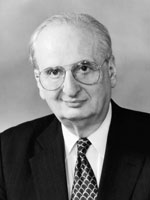
Judah Folkman
Harvard Medical School
A Burning Question
My first experience with the Gordon Research Conferences came in 1965. I had just finished my residency in surgery at Massachusetts General Hospital and had set up a laboratory at Boston City Hospital to investigate the results of an experiment dating back to my two years in the early 1960s at the Naval Medical Research Institute in Bethesda, Maryland. I wanted to know why melanoma cancer cells became dormant in rabbit thyroid glands perfused with hemoglobin in isolated glass chambers but grew into large tumors and sprouted capillary networks in mice. This had remained a burning question for me, but few leading scientists were interested in cancer research at the time, since many considered it career dooming to pursue research into such a hopeless disease. But I read about the 1965 Cancer Gordon Conference in
Science magazine and applied to attend.
I was enthralled to meet the great scientists there, like Charles Heidelberger, who was making tremendous progress in chemical carcinogenesis at the University of Wisconsin, and Harry Eagle, who had developed the first animal cell culture ten years earlier. I also met Richmond T. Prehn, with whom I would exchange ideas for the next twenty years. I was amazed that each speaker had the floor for a half-hour, unlike the mere ten minutes allotted at most other scientific and medical meetings.
I attended almost every Cancer GRC after 1965. For a number of years I did not tell anyone about the rabbit thyroid experiments because our conclusion that tumor growth depends on angiogenesis (the growth of new blood vessels) had been ridiculed by reviewers. But in 1971 the
New England Journal of Medicine published a talk I gave at Boston’s Beth Israel Hospital describing the ideas that angiogenesis was stimulated by a growth factor and that antiangiogenesis agents could possibly serve as effective cancer therapies. I was then for the first time invited by Prehn to speak at the next Cancer GRC. My talk stimulated a heated debate. Many pathologists argued that tumors had no blood vessels: they were simply white masses of tissue. As a surgeon I had removed many tumors from the body and had observed that they were filled with blood vessels. But there were no other surgeons at the conference to back up my observations. And besides, other attendees argued, how could one distinguish blood vessels feeding tumors from the inflammation that tumors were thought inevitably to cause?
At first the theory that tumors were angiogenesis-dependent was by nature difficult to demonstrate: the endothelial cells that make blood vessels had never been grown outside the body, and imaging technology that could show angiogenesis at work inside the body did not exist. Arguments presented at the Cancer GRC motivated me to find a way to gather the necessary evidence. GRC also brought together scientists from different disciplines who eventually contributed enormously to the understanding of cancer and angiogenesis. I remember one meeting in particular at which polymer scientists helped explain why putting a piece of plastic in a mouse’s skin causes a sarcoma. Rakesh K. Jain, who was originally a chemical engineer, helped biologists understand the fluid dynamics of vascular systems.
Of crucial importance for the field of angiogenesis research was the observation of Alexander Cruickshank, then GRC’s director, that interest in vascular biology and angiogenic inhibitors was growing at various conferences. At his suggestion Jain and I organized in 1995 the first Angiogenesis and Microcirculation Conference. Although in the early 1980s the medical community was still skeptical that angiogenesis inhibitors would be useful in patients, basic scientists had moved into the field from many different disciplines and from many countries. GRC provided a forum for the rapid advances taking place in understanding the molecular biology of the angiogenic process. Postdoctoral students and researchers from government and industry came to learn what was happening in the field, meet experts, and make funding and career connections. In fact, in the 1970s and 1980s Katherine Sanford and Colette Freeman from the National Cancer Institute gave me advice about grant writing because they heard me speak at a GRC.
GRC enabled the development of the field of angiogenesis research, which led to a modern understanding of cancer, macular degeneration, arthritis, and hemangioma-tosis as angiogenesis-dependent diseases, among others. Between 1995 and 2002 the number of papers about angiogenesis increased almost sevenfold, with nearly 1,400 papers published in 2002. Since the 1971 paper in the
New England Journal of Medicine appeared, more than 22,000 papers have been published with the word
angiogenesis in the title. New and old medicines, such as endostatin, Avastin, TNP-470, and thalidomide, now show promising results as therapies that have begun to prolong survival in cancer patients. These developments were greatly facilitated by GRC’s early recognition of the validity of scientific work in the field of angiogenesis research.